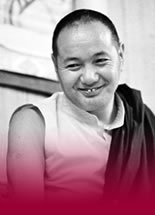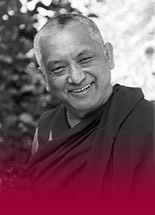Robina’s Blog
29 June, 2023
There are various levels of Buddhist practice. The most advanced, the most sophisticated level of understanding and working with and transforming the mind, is found in the Vajrayana, Tantrayana. For various technical reasons it's said to the be quickest path to buddhahood.
One of the essential practices is called deity yoga: the imagining, the visualizing of a particular buddha outside of you – deity is equivalent of buddha in tantra – and at some point in the sadhana, the stages of the visualization, you imagine that deity dissolving into you and you becoming the deity.
As you progress in your practice you eventually achieve exactly that: you become the buddha.
The lamas say that it's bringing the future result into the present: it's not just wishful thinking: it's a cause for it to happen.
There is Tara, let's say, in front of you. She, like all the buddhas, has all the qualities of an enlightened being, but she shows the particular aspect of action, power, confidence, one of the three essential qualities of a buddha. There is the compassion to want to benefit others, Chenrezig; the wisdom that knows how, Manjushri; and the power, the ability to do so, Tara.
We see her as a mirror image of our own potential; she shows us what we can become. This is so encouraging.
Recognizing that she is this, we imagine she comes to the crown of our head and happily dissolves into us and her body, speech and mind become oneness with our body, speech and mind. I identify with and practice becoming Tara.
This is the ultimate in positive psychology!
Lama Yeshe always felt from the beginning of his meeting with Western students in the 1970s that we could benefit from simple versions of these practices.
In the first stages of Buddhist practice we need to learn to harness the energy of our body and speech: don't harm others. Gradually we move to the next level where we become intimately familiar with our mind and learn to harness it, control it, subdue it, all based on the clear distinction between the neurotic deluded states of mind such as attachment and anger and jealousy and the virtuous constructive states of mind such as love and compassion and patience, let's say.
This is such hard work! At this stage there is much focus on the negative, which is the source of our own pain and why we harm others. We have our hands in our own shit.
Then we move to the Mahayana path and continue lessening the delusions and growing our virtues, gradually breaking down the barriers between self and other.
Now at the more advanced level of the Mahayana, we shift our focus to our good qualities, our virtues, our goodness, our wisdom, and identify with all of that by practicing the various deities, each of whom represent the goodness within us.
At the heart of these practices we cultivate what the lamas refer to as divine pride. I am this glorious, capable, wise being called Tara! So, so beneficial to think this way. Ironically it takes courage because we're addicted to believing in our negative qualities, identifying with them: I'm angry, I'm depressed, I'm not intelligent. No, not possible, I can't become a buddha. This is the irony of ego.
The fact is, we can. The potential to utterly rid our mind of the delusions and develop to perfection our wisdom and goodness is at our core: it's what defines us. Our mind is fundamentally pure.
These practices lift us, encourage us, open our hearts. By identifying with our future potential, we ripen it.

